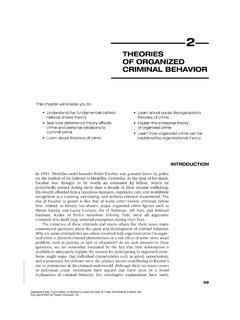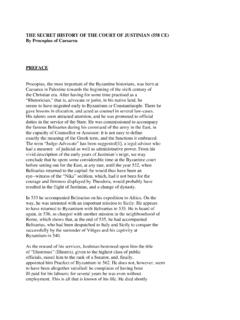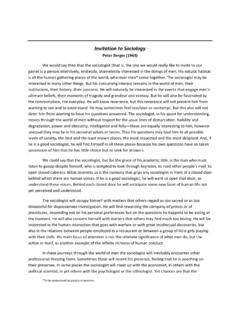Transcription of Peter L. Berger and Thomas Luckmann - Pearson
1 Berger and Luckmann s book The social construction of reality is subtitled A Treatise in the Sociology of Knowledge. The following excerpt from this book represents the authors views on how ordinary people come to define reality in their everyday life, and thus how they acquire and use knowledge to guide their behavior. The most important kind of social interaction, according to Berger and Luckmann , is that which is face-to-face with other people. social realities that is, what we regard as real and meaningful are created through reciprocal, fluid, and flexible interactions on a constant basis.
2 THE social construction OF reality Peter L. Berger and Thomas Luckmann 1. The reality of Everyday Life Since our purpose in this treatise is a sociological analysis of the reality of everyday life, more precisely, of knowledge that guides conduct in everyday life, and we are only tangentially interested in how this reality may appear in various theoretical perspectives to intellectuals, we must begin by a clarification of that reality as it is available to the commonsense of the ordinary members of society. How that commonsense reality may be influenced by the theoretical constructions of intellectuals and other merchants of ideas is a further question.
3 Ours is thus an enterprise that, although theoretical in character, is geared to the understanding of a reality that forms the subject matter of the empirical science of sociology, that is, the world of everyday life. It should be evident, then, that our purpose is not to engage in philosophy. All the same, if the reality of everyday life is to be understood, account must be taken of its intrinsic character before we can proceed with sociological analysis proper. Everyday life presents itself as a reality interpreted by men and subjectively meaningful to them as a coherent world.
4 As sociologists we take this reality as the object of our analyses. Within the frame of reference of sociology as an empirical science it is possible to take this reality as given, to take as data particular phenomena arising within it, without further inquiring about the foundations of this reality , which is a philosophical task. However, given the particular purpose of the present treatise, we cannot completely bypass the philosophical problem. The world of everyday life is not only taken for granted as reality by the ordinary members of society in the subjectively meaningful conduct of their lives.
5 It is a world that originates in their thoughts and actions, and is maintained as real by these. Before turning to our main task we must, therefore, attempt to clarify the foundations of knowledge in everyday life, to wit, the objectivations of subjective processes (and meanings) by which the intersubjective commonsense world is constructed. For the purpose at hand, this is a preliminary task, and we can do no more than sketch the main features of what we believe to be an adequate solution to the philosophical problem adequate, let us hasten to add, only in the sense that it can serve as a starting point for sociological analysis.
6 The considerations immediately following are, therefore, of the nature of philosophical prolegomena and, in themselves, presociological. The method we consider best suited to clarify the foundations of knowledge in everyday life is that of phenomenological analysis, a purely descriptive method and, as such, empirical but not scientific as we 1 understand the nature of the empirical The phenomenological analysis of everyday life, or rather of the subjective experience of everyday life, refrains from any causal or genetic hypotheses, as well as from assertions about the ontological status of the phenomena analyzed.
7 It is important to remember this. Commonsense contains innumerable pre- and quasi-scientific interpretations about everyday reality , which it takes for granted. If we are to describe the reality of commonsense we must refer to these interpretations, just as we must take account of its taken-for-granted character but we do so within phenomenological brackets. Consciousness is always intentional; it always intends or is directed toward objects. We can never apprehend some putative substratum of consciousness as such, only consciousness of something or other.
8 This is so regardless of whether the object of consciousness is experienced as belonging to an external physical world or apprehended as an element of an inward subjective reality . Whether I (the first person singular, here as in the following illustrations, standing for ordinary self-consciousness in everyday life) am viewing the panorama of New York City or whether I become conscious of an inner anxiety, the processes of consciousness involved are intentional in both instances. The point need not be belabored that the consciousness of the Empire State Building differs from the awareness of anxiety.
9 A detailed phenomenological analysis would uncover the various layers of experience, and the different structures of meaning involved in, say, being bitten by a dog, remembering having been bitten by a dog, having a phobia about all dogs, and so forth. What interests us here is the common intentional character of all consciousness. Different objects present themselves to consciousness as constituents of different spheres of reality . I recognize the fellowmen I must deal with in the course of everyday life as pertaining to a reality quite different from the disembodied figures that appear in my dreams.
10 The two sets of objects introduce quite different tensions into my consciousness and I am attentive to them in quite different ways. My consciousness, then, is capable of moving through different spheres of reality . Put differently, I am conscious of the world as consisting of multiple realities. As I move from one reality to another, I experience the transition as a kind of shock. This shock is to be understood as caused by the shift in attentiveness that the transition entails. Waking up from a dream illustrates this shift most simply. Among the multiple realities there is one that presents itself as the reality par excellence.



















